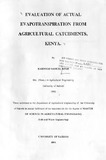| dc.description.abstract | Actual evapotranspiration was evaluated using three models viz water balance, Morton
and Grindley. The catchments used in the study were Oruba, Tugenon, Ndarugu and
Kimakia each having an area less than 100 sq. km. All the catchments lie in the humid
regions of Kenya. The first three catchments are chiefly vegetated with pasture, annual
and perennial crops whereas Kimakia is largely under forest.
The water balance method was implemented using daily rainfall data and runoff
hydrographs in a manner that allowed the estimation of actual evapotranspiration as the
difference between rainfall and runoff over a period of some days. The period in days
was determined from the receding limbs of the daily runoff hydrograph assuming the
linearity of runoff processes. The Morton model was implemented as documented in the
journal of hydrology (Netherlands) by Morton (1983) and all the calculations were done
on a monthly basis. Grindley model was implemented as documented in the text
"Hydrology in practice" by Shaw (1984). This model in essence is the extension of
Penman root constant concept and therefore proceeds with firstly computing the Penman
potential evapotranspiration values. The potential values are reduced to actual values by
involving soil moisture deficits and root constants for specified vegetations. Computation
of the above mentioned quantities in the Grindley model were done on a ten-day time
interval as prescribed by Grindley and then converted to monthly values.
The estimates of actual evapotranspiration by the three methods were compared basing
the water balance estimates as the standard ones. The annual evapotranspiration by the
water balance method ranged from 958.1 mm to 1352.1 mm while the coefficients of
variation varied between 0.05 and 0.08 in all the catchments. The results indicated that
the Grindley model tended to overestimate the actual evapotranspiration such that the
estimates were either equal or close to Penman potential evapotranspiration values in all
the catchments. Morton model performed better and actual evapotranspiration estimates
by the method, though marginally higher, were closer to the water balance based
estimates. The study, therefore, recommends that Morton model may be used in the
evaluation of the evapotranspiration component of the water balance. The additional
merit of the method lies in its ability to provide the estimates of actual
evapotranspiration solely on meteorological data, which are readily available in Kenya. | en |

